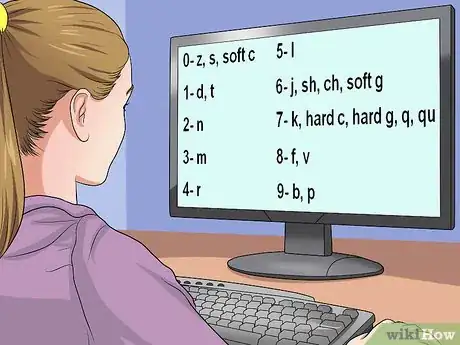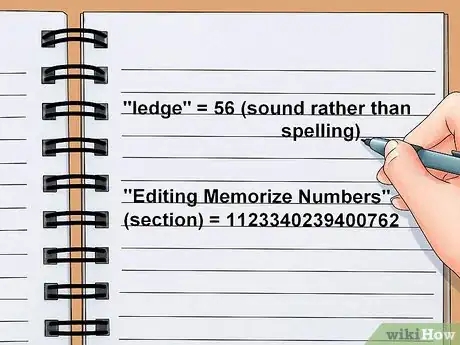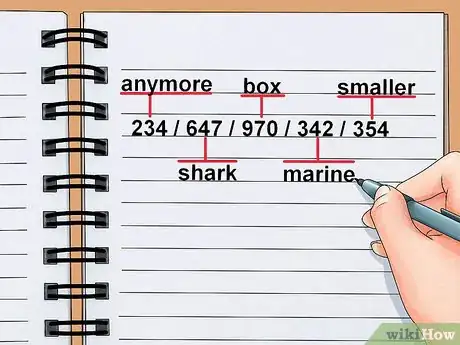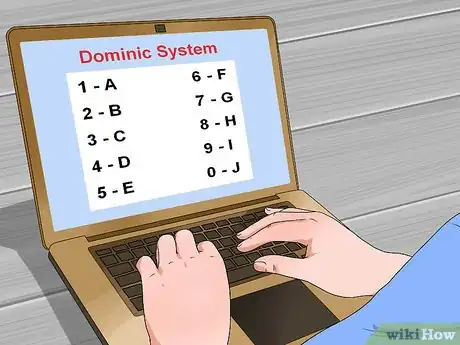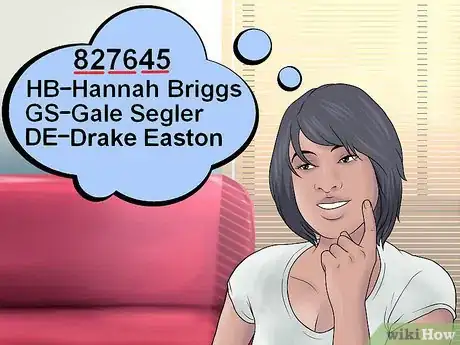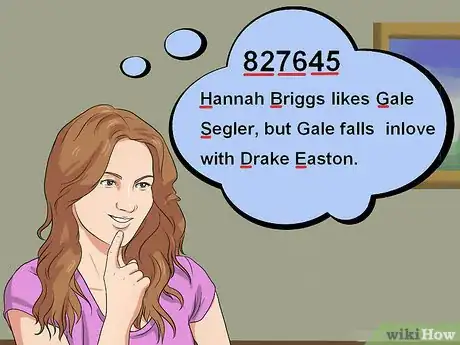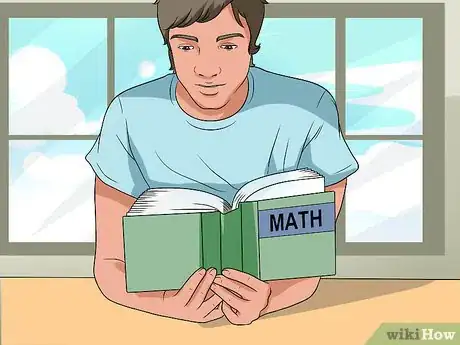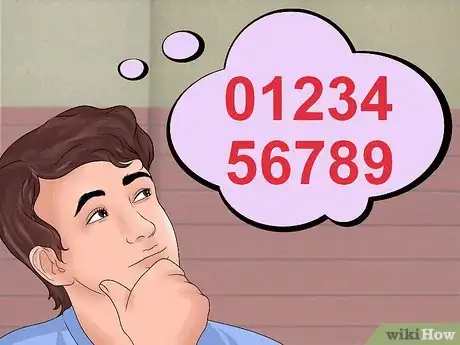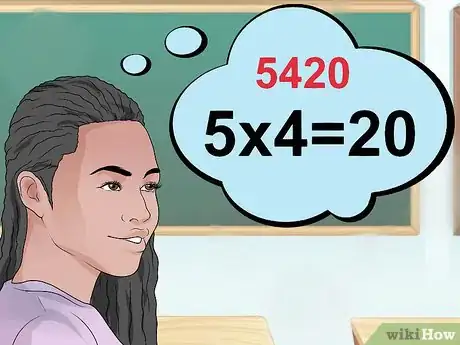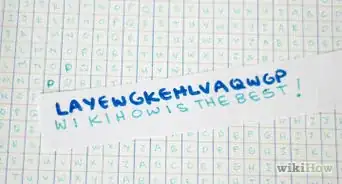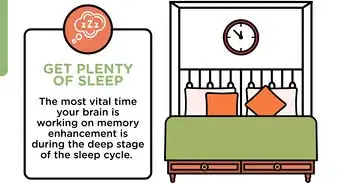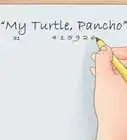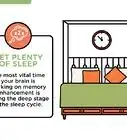This article was co-authored by wikiHow Staff. Our trained team of editors and researchers validate articles for accuracy and comprehensiveness. wikiHow's Content Management Team carefully monitors the work from our editorial staff to ensure that each article is backed by trusted research and meets our high quality standards.
There are 8 references cited in this article, which can be found at the bottom of the page.
wikiHow marks an article as reader-approved once it receives enough positive feedback. In this case, 80% of readers who voted found the article helpful, earning it our reader-approved status.
This article has been viewed 384,255 times.
Learn more...
The average person can hold a set of about seven digits in his/her working memory at any given time. Using the techniques below, however, you can memorize many, many more. The key is to employ mnemonics, which means building associations that are easier to remember than random numbers. Bear in mind that mathematics is much more than rote memorization – deep knowledge is about understanding higher level concepts.
Steps
Using the Major System
-
1Learn the rules. This is also known as the "consonant system" or "phonetic system." You build associations between each individual number and a sound. Since words are easier to remember than numbers, you construct a word from each group of numbers and then memorize the word(s).[1]
- The associations you choose to make are up to you. There is no right or wrong answer as long as you continue to make the same associations as you continue to use this technique.
-
2Study which consonants commonly correspond to which numbers. Each number is assigned a consonant based on some kind of recognizable relationship between the two:[2]
- 0 - z, s, soft c - "z" is the first letter of zero. The others have a similar sound
- 1 - d, t - t has one downstroke d has as similar sound (some variants include th)
- 2 - n - n has two downstrokes.
- 3 - m - three downstrokes, also "3" looks like "m" on its side
- 4 - r - last letter of four
- 5 - l - L is the Roman numeral for 50
- 6 - j, sh, ch, soft g - a script j has a lower loop / g is almost a 6 rolled around
- 7 - k, hard c, hard g, q, qu - capital K contains two sevens
- 8 - f, v - script f looks like a figure-8 (some variants include th)
- 9 - b, p - P is a mirror-image 9, b sounds similar
Advertisement -
3Notice that similar sounds are grouped together. The system goes by sound rather than spelling, and the unused sounds (vowels and the consonants "w," "h," and "y") can be put into a word anywhere without changing the value.
-
4Practice by taking some words and determining which numbers go with them. After a few minutes of this, you will know the system.[3]
- "ledge" = 56 (sound rather than spelling)
- "Editing Memorize Numbers (section)" = 1123340239400762
-
5Take some phone numbers and make words and phrases out of them. Add vowels between the consonants to make meaningful words. Use your imagination and try to make them funny and outrageous (which will make them easier to remember). After a short while this becomes automatic, and you will be surprised how easy it is to form memorable words out of seemingly random numbers.[4]
- 31415926 (the first 8 digits of pi) = "my turtle, Pancho"
- 7713370 (a made up phone number) = "cooked mom eggs"
- Break that into chunks. Try the following game:-
- Two phone number are given. Say which is easier to remember. After that, remember the following number.
- It may be hard for you to remember.
-
6Break up large numbers into word phrases. If the number is very large, break it up into a series of words, and then memorize the list of words using any of the following techniques:[5]
- How to Memorize Lists Using the Pure Link System
- How to Remember Lists of Words With the Roman Room Trick
- How to Build a Memory Palace
Using the Dominic System
-
1Learn the rules. Like in the major system, you assign each number a letter, although the associations are arbitrary. After converting the numbers to letters, you associate those letters with people and actions in the form of a story.[6]
-
2Convert each individual number into a letter. Choose common letters that will be easy to make associations with. Consider using the following examples:[7]
- A
- B
- C
- D
- E
- S
- G
- H
- N
- O
-
3Divide the letters into pairs. Mentally breaking up the sequencing of a longer number into several pairs of numbers will help you remember it more easily. For example: 827645 = HB GS DE
-
4Associate each pair with a person with those initials. Try to think of someone you know with those initials. Connecting your memory of the person to the image of the number will make it stick in your mind more firmly.[8]
-
5Associate each person with a particular action. Again, this is a way to increase the ease with which you’ll be able to remember the numbers. Association is key here. Link the number pair to some action that will be easier to remember than just a random list of numbers.[9]
- When assigning meanings to each pair of numbers, alternate between people and actions.
Using Math
-
1Learn the rules. Using simple math problems can be a great way to help your mind remember longer numbers. By associating the sequence of numbers into a logical mathematical equation, it can be a foolproof way to memorize numbers.
- Of course, this method really only works for numbers that you can choose yourself because not all number sequences will also function as a math equation.
-
2Choose numbers that work with this method. For passwords, PIN, and phone numbers choose sets of numbers that can be made into simple math problems. This way you can memorize them without substituting letters for the original numbers.[10]
-
3Create simple math problems to help you remember numbers. Think of numbers that also function as math equations and choose those. You can use addition, subtraction, multiplication, division, fractions – basically any kind of math problem you want – as long as it helps you remember the number sequence.
- For example, 5420 is easily remembered as 5x4=20 or "five times four equals twenty."
- Example: 62311 or 6+2+3=11
- Example: 21293 or 21=2x9+3
Community Q&A
-
QuestionIf im memorizing numbers for a test, isnt that cheating?
 Community AnswerNot necessarily. If you are looking at an answer key to the test, then memorizing a series of prefabricated correct answers, then yes. However using these methods to increase your ability to remember things like mathematical constants (e.g. Avogadro's number), important dates (e.g. 07/04/1776), or even full equations isn't cheating at all!
Community AnswerNot necessarily. If you are looking at an answer key to the test, then memorizing a series of prefabricated correct answers, then yes. However using these methods to increase your ability to remember things like mathematical constants (e.g. Avogadro's number), important dates (e.g. 07/04/1776), or even full equations isn't cheating at all!
References
- ↑ https://artofmemory.com/blog/major-system/
- ↑ https://artofmemory.com/blog/major-system/
- ↑ http://www.academictips.org/memory/majorsys.html
- ↑ https://litemind.com/major-system/
- ↑ https://artofmemory.com/wiki/Person-Action-Object_(PAO)_System/
- ↑ https://artofmemory.com/wiki/Dominic_System/
- ↑ https://artofmemory.com/wiki/Dominic_System/
- ↑ http://www.academictips.org/memory/dominic.html
- ↑ http://peoplebyinitials.com/p/dominic-number-memory-system
About This Article
To memorize numbers, try giving each number a letter sound using the Major system and practice taking a few words and turning them into number sequences. When you’ve memorized the system, make up a number sequence and turn it into a word. If the number is long, you can turn it into a series of words to make it easier to remember. You could also create your own individual code for turning numbers into letters, as long as the associations are meaningful to you, which is what makes it easier to remember. For tips on how to memorize a sequence of numbers by turning it into a math equation, read on!

